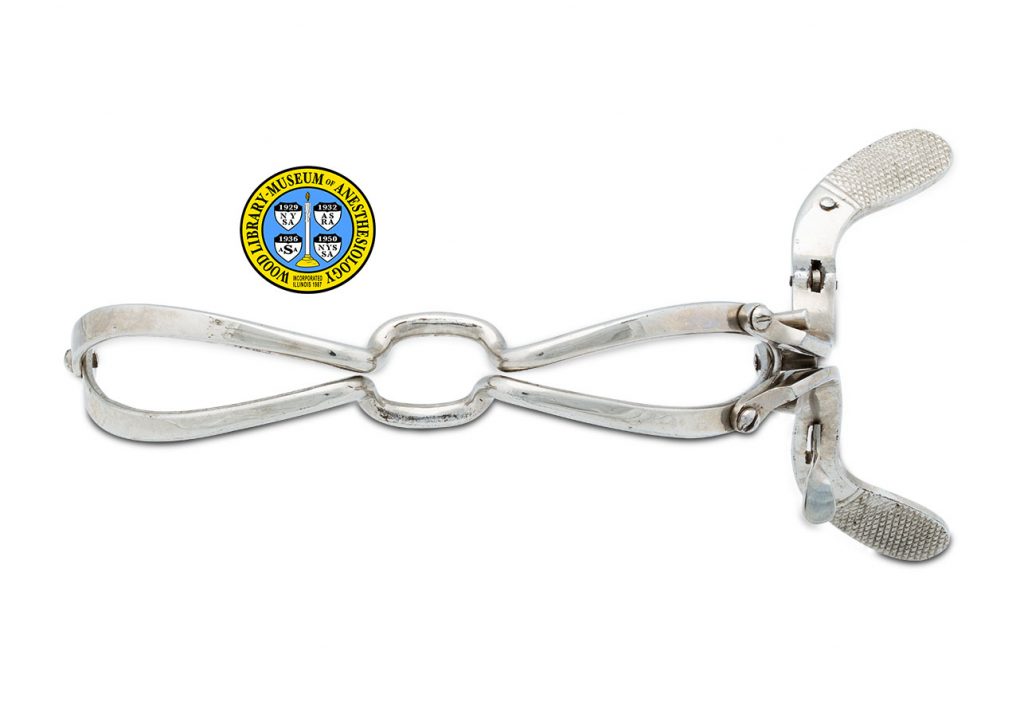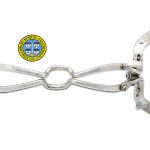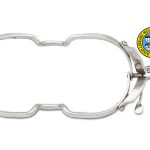Jennings Cleft Palate Gag
Anesthesiologists are responsible for maintaining the patient's respiration and other vital functions during surgery. Mouth gags are sometimes used to hold the patient's mouth open for dentistry, oral surgery and anesthesia. Surgical procedures for the repair of cleft palate began in the 18th Century. The first successful cleft palate surgery in the United States was performed in 1820 by John Collins Warren (1778-1856). Since the mid-19th Century, many mouth gags have been designed specifically for these surgeries. One was introduced in 1914 by St. Louis physician John Ellis Jennings (1863-1935).
Jennings' gag is a modification of the Whitehead gag, which had been introduced some fifty years earlier. Jennings removed the built-in tongue depressor of Whitehead's gag, and simplified the mechanism for adjusting it. The Whitehead gag has two spring-loaded ratchets. The Jennings gag has a single ratchet that can be operated by the finger and thumb of one hand. Squeezing the handles together opens the gag. To close it, the ratchet is depressed and the handles pushed apart. Both the Whitehead and Jennings gags are still being made today.
Catalog Record: Jennings Cleft Palate Gag Jennings Gag
Access Key: aqli
Accession No.: 2010-09-23-7 I
Title: [Jennings cleft palate mouth gag].
Publisher: Place of manufacture unidentified : manufacturer unidentified, [between 1914 and 2010].
Physical Description: 1 mouth gag ; metals ; 6 x 18.5 x 9 cm.
Subject: Anesthesia, Inhalation – instrumentation.
Subject: Airway Management – instrumentation.
Subject: Mouth Gags.
Note Type: General
Notes: The first year in date range is based on the date of Jennings’ original description of the gag. The second year in the date range is based on the date that the gag was received by the WLM, but it’s fragility suggests that it is more likely to have been manufactured in the first half of the 20th century.
The “JS” logo stamped on the object is unknown to the cataloger. It is unlike the caduceus logo of the German manufacturer, Jetter & Scheerer.
Described from the operator’s perspective, with the ratchet on the right and the handles extending forward.
Note Type: Citation
Notes: Ancestry.library.com. Accessed June 16, 2017.
Note Type: Citation
Notes: Austrian Difficult Airway/Intubation Registry, Virtual Museum of Equipment for Airway Management. http://www.adair.at/eng/museum/equipment/mouthgags/jenningsobject01.htm Accessed June 13, 2017.
Note Type: Citation
Notes: Austrian Difficult Airway/Intubation Registry, Virtual Museum of Equipment for Airway Management. http://www.adair.at/eng/museum/equipment/mouthgags/whiteheadobject01.htm. Accessed June 13, 2017.
Note Type: Citation
Notes: Jennings JE. A new tonsillectome. JAMA. May 24, 1913;60(21):1620.
Note Type: Citation
Notes: Jennings JE. The complete removal of the tonsil in its capsule (Sluder method) by means of a new tonsillotome. Medical Fortnightly. 1914; 45:56-58.
Note Type: Citation
Notes: Leow A-M, Lun-Jou L. Palatoplasty: evolution and controversies. Chang Gung Med J. 2008;31(4):335-345.
Note Type: Citation
Notes: Millard DR. Cleft Craft, vol. 3: Alveolar and Palatal Deformities:141-157. In: University of Miami, Leonard M. Miller School of Medicine, Louis Calder Memorial Library website, electronic books webpage. http://calder.med.miami.edu/Ralph_Millard/cleftcraft/Vol%203/01%20%20Basics/06.pdf Accessed June 14, 2017.
Note Type: Citation
Notes: Powers & Anderson. Illustrated Catalogue of Surgical Instruments and of Allied Lines. Richmond, Virginia: Powers & Anderson, Inc., 1917:355.
Note Type: Citation
Notes: Tiemann, George, & Co. Catalogue of Surgical Instruments. New York: George Tiemann & Co. 1876:60.
Note Type: Citation
Notes: Whitehead, WR. Report on the best methods of treatment for different forms of cleft palate. Transactions of the American Medical Association, Volume XX. Philadelphia: Collins, 1869.
Note Type: Citation
Notes: Whitehead, WR. Dr. Whitehead’s Gag and his Cleft Palate Cases. Rocky Mountain Medical Times. 1882; 1:194-200, 1882.
Note Type: Physical Description
Notes: One mouth gag; Consists of two sculpted, horizontal bars, hinged together at each end, and connected on the right side to a mechanism for adjusting the space between the bars; The mechanism consists of two handles that are hinged so as to stand perpendicular to the bars; These handles hold a ratchet between them; The end of each handle is scored by hatching on its exterior side (for improved grip); In the short physical description the gag is measured in the fully open position; When the gag is fully closed, the height is 8.5 centimeters; Both bars, and both handles, are marked on the interior with the number: “25”; The lower handle is also marked with the logo, consisting of a circle enclosing the letter “J” superimposed on the letter “S”.
Note Type: Reproduction
Notes: Photographed by Mr. Steve Donisch, June 20, 2017.
Note Type: Acquisition
Notes: Gift of Lucien E. Morris, M.D.
Note Type: Historical
Notes: Anesthesiologists are responsible for maintaining the patient’s respiration and other vital functions during surgery. Mouth gags are sometimes used to hold the patient’s mouth open for dentistry, oral surgery and anesthesia. Surgical procedures for the repair of cleft palate began in the 18th Century. The first successful cleft palate surgery in the United States was performed in 1820 by John Collins Warren (1778-1856). Since the mid-19th Century, many mouth gags have been designed specifically for these surgeries.
St. Louis physician John Ellis Jennings (1863-1935) introduced a new tonsillectome (an instrument for removing tonsils) in 1913; in that article he does not mention the use of any mouth gag. The following year he published another article about the use of the instrument, which included an illustration of “the Jennings mouth gag”.
The Jennings gag is a modification of the gag introduced in the 1860s by William R. Whitehead, M.D. (1831-1902). Jennings removed the built-in tongue depressor of the Whitehead gag, and simplified the mechanism for opening and closing it. The Whitehead gag has two spring-loaded ratchets. The Jennings gag uses a single ratchet, located on the operator’s right, that can be manipulated by the finger and thumb of one hand. Squeezing the handles together opens the gag. To close it, the ratchet is depressed and the handles pushed apart. Both the Whitehead and Jennings gags are still being made today.
Note Type: Publication
Notes: Whitehead WR. Dr. Whitehead’s Gag and his Cleft Palate Cases. Rocky Mountain Medical Times. 1882;1:194-200, 1882.
Note Type: Exhibition
Notes: Selected for the WLM website.



